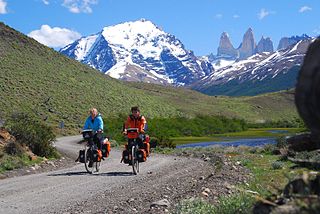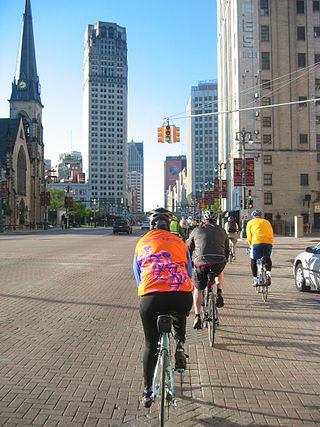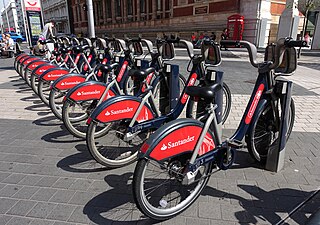Related Research Articles

Bicycle touring is the taking of self-contained cycling trips for pleasure, adventure or autonomy rather than sport, commuting or exercise. Bicycle touring can range from single-day trips to extended travels spanning weeks or months. Tours may be planned by the participant or organized by a tourism business, local club or organization, or a charity as a fund-raising venture.

Bicycle Network is an Australian charity, one of the largest cycling membership organisations in the world, whose mission is to have More People Cycling More Often. Before 2011 it was known as Bicycle Victoria.
Adventure Cycling Association is a nonprofit member organization focused on travel by bicycle. Headquartered in Missoula, Montana, Adventure Cycling develops cycling routes, publishes maps, provides guided trips, and advocates for better and safer cycling in the U.S. The organization grew from a mass cross-country bicycle ride in 1976 to celebrate the U.S. Bicentennial. Adventure Cycling also publishes a magazine, Adventure Cyclist.

Since the advent of the bicycle in the 1860s, Chicago has been distinguished as one of the premier cycling locations in the United States, with such public cycling destinations as Grant Park, Burnham Park and the Chicago Park District's Lakefront Trail.

Cycling advocacy consists of activities that call for, promote or enable increased adoption and support for cycling and improved safety and convenience for cyclists, usually within urbanized areas or semi-urban regions. Issues of concern typically include policy, administrative and legal changes ; advocating and establishing better cycling infrastructure ; public education regarding the health, transportational and environmental benefits of cycling for both individuals and communities, cycling and motoring skills; and increasing public and political support for bicycling.

Sheldon Brown was an American bicycle mechanic, technical expert and author. He contributed to print and online sources related to bicycling and bicycle mechanics, in particular the web site Sheldon Brown's Bicycle Technical Info. His knowledge of bicycles was described as "encyclopaedic" by The Times of London.

Cycling is a popular mode of transport and leisure activity within London, the capital city of the United Kingdom. Following a national decline in the 1960s of levels of utility cycling, cycling as a mode of everyday transport within London began a slow regrowth in the 1970s. This continued until the beginning of the 21st century, when levels began to increase significantly—during the period from 2000 to 2012, the number of daily journeys made by bicycle in Greater London doubled to 580,000. The growth in cycling can partly be attributed to the launch in 2010 by Transport for London (TfL) of a cycle hire system throughout the city's centre. By 2013, the scheme was attracting a monthly ridership of approximately 500,000, peaking at a million rides in July of that year. Health impact analyses have shown that London would benefit more from increased cycling and cycling infrastructure than other European cities.

Cycling in Copenhagen is – as with most cycling in Denmark – an important mode of transportation and a dominating feature of the cityscape, often noticed by visitors. The city offers a variety of favourable cycling conditions — dense urban proximities, short distances and flat terrain — along with an extensive and well-designed system of cycle tracks. This has earned it a reputation as one of the most bicycle-friendly cities in the world. Every day 1.2 million kilometres are cycled in Copenhagen, with 62% of all citizens commuting to work, school, or university by bicycle; in fact, almost as many people commute by bicycle in greater Copenhagen as do those cycle to work in the entire United States. Cycling is generally perceived as a healthier, more environmentally friendly, cheaper, and often quicker way to get around town than by using an automobile.

Mixed terrain cycle touring is the practice of cycling over a variety of surfaces and topography on a single route, with a single bicycle. The recent popularity of mixed terrain touring is in part a reaction against the increasing specialization of the bike industry.

Detroit is a popular city for cycling. It is flat with an extensive road network with a number of recreational and competitive opportunities and is, according to cycling advocate David Byrne, one of the top eight biking cities in the world. The city has invested in greenways and bike lanes and other bicycle-friendly infrastructure. Bike rental is available from the riverfront and tours of the city's architecture can be booked.

Santander Cycles is a public bicycle hire scheme in London in the United Kingdom. The scheme's bicycles are popularly and colloquially known as Boris Bikes, after Boris Johnson who was Mayor of London when the scheme began operating.
Cycling in Australia is a common form of transport, recreation and sport.

Cycling is a common means of transportation, sport, and recreation in Paris, France. As of 2021, about 15% of trips in the city are made by bicycle, taking place on over 1,000 km (620 mi) of cycling paths. The Tour de France, the largest sporting event in cycling, finishes on the Champs-Élysées. Four major recreational cycling routes—EuroVelo 3, Avenue Verte, the Seine à Vélo, and the Veloscenic—pass by Notre-Dame Cathedral.

Some countries and lower jurisdictions have enacted laws or regulations which require cyclists to wear a helmet in certain circumstances, typically when riding on the road or a road-related area. In some places this requirement applies only to children under a certain age, while in others it applies to cyclists of all ages.
Bill Strickland is an American journalist, book author and editor whose work focuses primarily on the sport of cycling. He has twice served as Bicycling magazine's editor in chief, from 1999 to 2003 and currently starting in 2014. Strickland is an amateur road and cyclocross racer, and rides for the club Kapelmuur Independent.

Cycling for transport and leisure enjoys popularity in Greater Manchester and the city also plays a major role in British cycle racing. The Bee Network was launched in 2018. The University of Manchester is home to the Manchester Cycling Lab.

Cold-weather biking, cold-weather cycling, or winter biking is the use of a bicycle during months when roads and paths are covered with ice, slush and snow. Cold weather cyclists face a number of challenges in near or below freezing temperatures. Urban commuters on city streets may have to deal with "[s]now, slush, salt, and sand", which can cause rust and damage to metal bike components. Slush and ice can jam derailleurs. Some cyclists may bike differently in winter, by "slow[ing] down on turns and brak[ing] gradually" in icy conditions. Gaining traction on snow and ice-covered roads can be difficult. Winter cyclists may use bikes with front and rear fenders, metal studded winter tires and flashing LED lights. Winter cyclists may wear layers of warm clothes and "ea[r], face, and han[d]" coverings may be used. Specialized winter bikes called fatbikes, which have wide, oversized tires that are typically inflated with low pressure, are used in snow trail riding and winter bike competitions.
The TransAmerica Bicycle Trail was the first bicycle touring route to cross the U.S. It was developed and mapped by Adventure Cycling Association, and travels between Astoria, Oregon, and Yorktown, Virginia, along mostly rural, two-lane highways.

Cycling infrastructure in the Canadian city of Halifax, Nova Scotia includes most regular streets and roads, bike lanes, protected cycle tracks, local street bikeways, and multi-use pathways.
References
- ↑ Robert Lee Brewer (2 September 2011). 2012 Writer's Market Deluxe Edition. Writer's Digest Books. p. 691. ISBN 1-59963-227-6 . Retrieved 12 June 2016.
- ↑ "Adventure Cycling timeline" . Retrieved 23 March 2016.
- ↑ https://missoulian.com/news/local/missoulas-adventure-cyclist-rare-indie-magazine-gets-update/article_6796a06a-ed46-5108-b2bf-d8a4ba06a366.html
- ↑ "Alex Strickland named editor-in-chief at Adventure Cyclist as Deme becomes executive editor". Bicycle Retailer. Missoula. 3 November 2015. Retrieved 12 June 2016.
- ↑ https://www.bicycleretailer.com/announcements/2021/05/17/carolyne-whelan-joins-adventure-cycling-editor-chief-adventure-cyclist